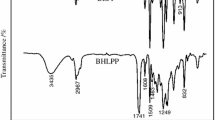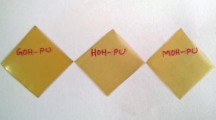Abstract
Two series of self curable polyurethanes were synthesized using an aliphatic diisocyanate (isophorone diisocyanate), an anionic diol (2-bis(hydroxymethyl) propionic acid) and two different soft segments poly(1,4-butylene adipate) end capped diol (semicrystalline polyester) and poly (propylene glycol) end capped diol (amorphous polyether). In both cases the polyurethanes were end-capped with (3-aminopropyl)triethoxysilane to impart the films the ability to crosslink at room temperature. The thermal and mechanical properties of the cured films can be tailored with the alkoxysilane concentration. Thus, as the alkoxysilane content increases, the resulting systems present a higher degree of phase separation, according to both DSC and DMTA results. In addition, TGA results confirm that their thermal stability also increases and finally, the modulus increases and the strain decreases as a function of the crosslinking degree.











Similar content being viewed by others
References
Chattopadhyay DK, Webster DC (2009) Thermal stability and flame retardancy of polyurethanes. Prog Polym Sci 34:1068–1133
Nanda AK, Wicks DA (2006) The influence of the ionic concentration, concentration of the polymer, degree of neutralization and chain extension on aqueous polyurethane dispersions prepared by the acetone process. Polymer 47:1805–1811
Hepburn C (1993) Polyurethane elastomers, 2nd edn. Elsevier, London
Madhavan K, Gnanasekaran D, Reddy B (2011) Poly(dimethylsiloxane-urethane) membranes: effect of linear siloxane chain and caged silsesquioxane on gas transport properties. J Polym Res 18:1851–1861
Kim BK (1996) Aqueous polyurethane dispersions. Colloid Polym Sci 275:599–611
Dieterich D (1981) Aqueous emulsions, dispersions and solutions of polyurethanes; synthesis and properties. Prog Org Coat 9:281–340
Li CY, Chiu WY, Don TM (2005) Preparation of polyurethane dispersions by miniemulsion polymerization. J Polym Sci Part A Polym Chem 43:4870–4881
Sardon H, Irusta L, Fernandez-Berridi MJ (2009) Synthesis of isophorone diisocyanate (IPDI) based waterborne polyurethanes: Comparison between zirconium and tin catalysts in the polymerization process. Prog Org Coat 66:291–295
Subramani S, Lee JM, Lee JY, Kim JH (2007) Synthesis and properties of room temperature curable trimethoxysilane-terminated polyurethane and their dispersions. Polym Adv Technol 18:601–609
Subramani S, Cheong IW, Kim JH (2004) Synthesis and characterizations of silylated polyurethane from methyl ethyl ketoxime-blocked polyurethane dispersion. Eur Polym J 40:2745–2755
Wang S, Chen P, Hwang J, Yeh J, Huang C, Chen K (2012) Performance properties of self-curing aqueous-based PU system with tri-glycidyl phosphate curing agent. J Polym Res 19:1–10
Kim BK, Yang JS, Yoo SM, Lee JS (2003) Waterborne polyurethanes containing ionic groups in soft segment. Colloid Polym Sci 281:461–468
Bao L, Lan Y, Zhang S (2006) Synthesis and properties of waterborne polyurethane dispersions with ions in the soft segments. J Polym Res 13:507–514
Song C, Yuan Q, Wang D (2004) Effect of the content of urea groups on the particle size in water-borne polyurethane or polyurethane/polyacrylate dispersions. Colloid Polym Sci 282:642–645
Sardon H, Irusta L, Fernández-Berridi MJ, Lansalot M, Bourgeat-Lami E (2010) Synthesis of room temperature self-curable waterborne hybrid polyurethanes functionalized with (3-aminopropyl)triethoxysilane (APTES). Polymer 51:5051–5057
Xiaojuan L, Xiaorui L, Lei W, Yiding S (2010) Synthesis and characterizations of waterborne polyurethane modified with 3-aminopropyltriethoxysilane. Polym Bull 65:45–57
Yeh JM, Yao CT, Hsieh CF, Yang HC, Wu CP (2008) Preparation and properties of amino-terminated anionic waterborne-polyurethane–silica hybrid materials through a sol–gel process in the absence of an external catalyst. Eur Polym J 44:2777–2783
Sardon H, Irusta L, Fernández-Berridi MJ, Luna J, Lansalot M, Bourgeat-Lami E (2011) Waterborne polyurethane dispersions obtained by the acetone process: a study of colloidal features. J Appl Polym Sci 120:2054–2062
Barni A, Levi M (2003) Aqueous polyurethane dispersions: a comparative study of polymerization processes. J Appl Polym Sci 88:716–723
Wang L, Shen Y, Lai X, Li Z, Liu M (2011) Synthesis and properties of crosslinked waterborne polyurethane. J Polym Res 18:469–476
Xiaojuan L, Yiding S, Lei W (2011) Preparation and properties of self-crosslinkable polyurethane/silane hybrid emulsion. J Polym Res 18:2425–2433
Camberlin Y, Pascault JP (1983) Quantitative DSC evaluation of phase segregation rate in linear segmented polyurethanes and polyurethaneureas. J Polym Sci Part A Polym Chem 21:415–423
Kwon J, Rahman M, Kim H (2006) Preparation and properties of crosslinkable waterborne polyurethanes containing aminoplast. Fibers Polym 7:95–104
Kanapitsas A, Pissis P, Gomez-Ribelles JL, Monleon-Pradas M, Privalko EG, Privalko VP (1999) Molecular mobility and hydration properties of segmented polyurethanes with varying structure of soft and hard chain segments. J Appl Polym Sci 71:1209–1221
Rekondo A, Irusta L, Fernandez-Berridi MJ (2010) Characterization of silanized poly(ether-urethane) hybrid systems using thermogravimetric analysis (TG). J Therm Anal Calorim 101:331–337
Acknowledgments
The authors would like to thank the financial support of the Basque Government (Etortek, iNanogune II project, and Ayudas a grupos de investigación del sistema Universitario vasco ITT444-10) for the development of this work.
Author information
Authors and Affiliations
Corresponding author
Rights and permissions
About this article
Cite this article
Sardon, H., Irusta, L., Santamaría, P. et al. Thermal and mechanical behaviour of self-curable waterborne hybrid polyurethanes functionalized with (3-aminopropyl)triethoxysilane (APTES). J Polym Res 19, 9956 (2012). https://doi.org/10.1007/s10965-012-9956-8
Received:
Accepted:
Published:
DOI: https://doi.org/10.1007/s10965-012-9956-8




